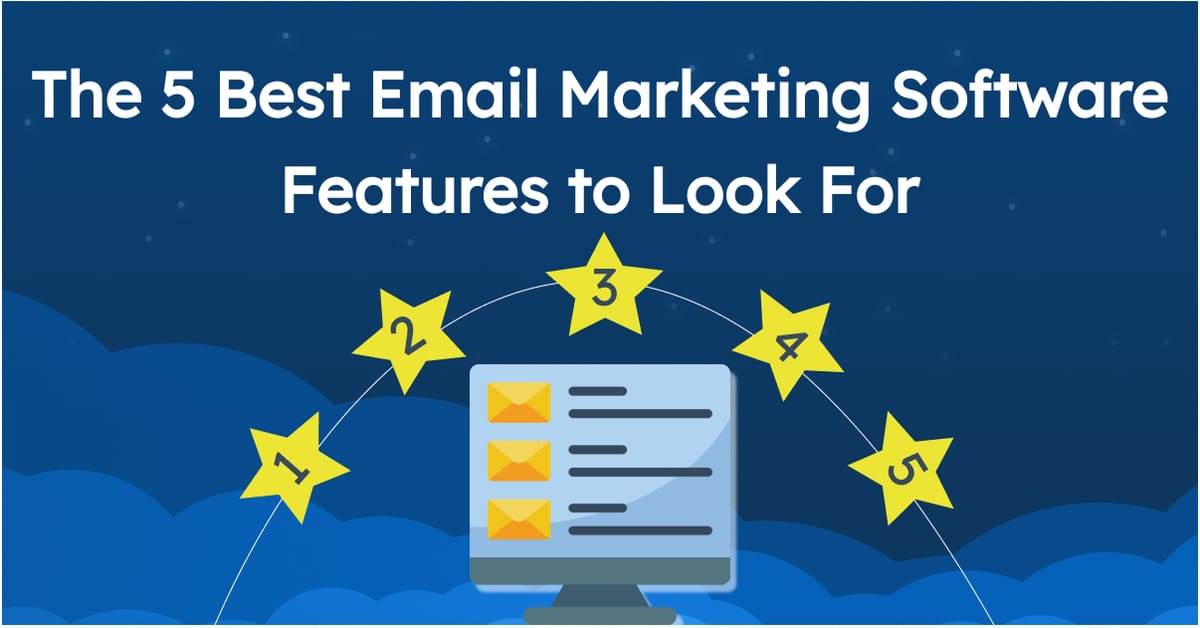Email marketing is a vital tool for businesses today. It helps connect with customers efficiently.
Choosing the right email marketing tool can make a huge difference. The right features can save time and boost engagement. But with so many options, how do you choose the best one? This guide will help you understand what to look for.
We’ll explore essential features that make an email marketing tool effective. Whether you are a small business or a large corporation, knowing these features can enhance your email campaigns. Let’s dive in and discover what makes an email marketing tool truly valuable.

Credit: 500apps.com
User-friendly Interface
Choosing the right email marketing tool can be tough. One key feature to consider is a User-Friendly Interface. This can save you time and make your work easier. A tool with a good interface is easy to use and helps you focus on your campaigns.
Easy Navigation
An email marketing tool should have easy navigation. You want to find what you need quickly. Look for clear menus and simple buttons. This will help you move through the tool without getting lost.
A well-organized dashboard is also important. It should show you all the key features at a glance. This helps you manage your email campaigns more efficiently.
Customizable Templates
Customizable templates can save you a lot of time. These templates let you create professional emails without starting from scratch. Look for tools that offer a variety of templates to choose from.
You should also be able to tweak these templates. This means changing colors, fonts, and images to match your brand. A good tool will make this easy to do, even for beginners.
| Feature | Benefit |
|---|---|
| Easy Navigation | Quick access to features |
| Customizable Templates | Save time on design |
| Organized Dashboard | Efficient campaign management |
- Clear menus and buttons
- Variety of templates
- Easy to customize
- Well-organized dashboard
In summary, a User-Friendly Interface is key for any email marketing tool. Make sure the tool you choose has easy navigation and customizable templates. This will make your email marketing efforts more effective and less stressful.

Credit: www.elegantthemes.com
Automation Capabilities
Email marketing tools are essential for effective communication. One of the most crucial features is automation capabilities. Automation saves time and ensures consistent engagement with your audience. It helps in managing campaigns efficiently. Let’s explore some key automation features you should look for.
Drip Campaigns
Drip campaigns are a series of pre-scheduled emails. They are sent out at specific intervals. These campaigns guide your audience through a journey. It can start with a welcome email. Follow-up emails can provide more information or promotions. Drip campaigns keep your audience engaged. They also help in nurturing leads without manual effort.
Triggered Emails
Triggered emails are sent based on specific actions. These actions are taken by your audience. For example, signing up for a newsletter can trigger a welcome email. Abandoning a cart can trigger a reminder email. Triggered emails are highly relevant. They increase engagement and conversion rates. They also ensure timely communication with your audience.
Segmentation Options
When choosing an email marketing tool, segmentation options are crucial. They help you target the right audience. Effective segmentation can boost engagement and conversions. Let’s explore important segmentation features.
Advanced Filtering
Advanced filtering allows you to create precise segments. You can use multiple criteria to target specific groups. Some common filters include:
- Demographics (age, gender, location)
- Purchase history
- Engagement levels
- Subscription date
With these filters, you can send personalized emails. For example, send promotions to frequent buyers or re-engagement emails to inactive users. Advanced filtering ensures your messages are relevant.
Behavioral Targeting
Behavioral targeting focuses on user actions. This includes website visits, email opens, and clicks. By tracking these behaviors, you can create dynamic segments.
Here are some examples of behavioral triggers:
| Behavior | Segment |
|---|---|
| Visited product page | Potential buyers |
| Opened last 3 emails | Engaged subscribers |
| Clicked on a link | Interested in a specific topic |
Behavioral targeting helps you send timely and relevant emails. This increases the chances of conversion. For example, send a follow-up email to someone who visited a product page but did not buy.
Analytics And Reporting
Analytics and reporting are crucial for any email marketing campaign. They help you understand your audience better and track the success of your emails. A good email marketing tool should offer comprehensive analytics and reporting features. These features allow you to make data-driven decisions and improve your marketing strategy.
Real-time Data
Real-time data is essential in email marketing. It shows how your emails perform as soon as they are sent. This feature helps you monitor open rates, click-through rates, and other key metrics instantly. With real-time data, you can quickly see how your audience is engaging with your content.
Real-time data also allows you to make immediate adjustments. If you notice that an email is not performing well, you can make changes on the fly. This immediate feedback loop is invaluable for optimizing your campaigns.
Performance Metrics
Performance metrics give you a detailed view of your email campaigns. They show you how effective your emails are in achieving your goals. Key metrics include open rates, click-through rates, bounce rates, and conversion rates.
Open rates tell you how many people opened your email. Click-through rates show how many people clicked on links within your email. Bounce rates indicate how many emails were not delivered. Conversion rates measure how many recipients completed a desired action.
By analyzing these metrics, you can understand what works and what doesn’t. You can identify trends and patterns in your email campaigns. This insight helps you refine your strategy and improve future campaigns.
Integration With Other Tools
Integration with other tools is vital for an email marketing tool. It helps streamline your marketing efforts and ensures smooth operations. When choosing an email marketing tool, consider its compatibility with your existing systems. This will save you time and resources.
Crm Integration
CRM integration is a must-have feature. It allows you to manage customer relationships effectively. By linking your email tool with your CRM, you can personalize your emails. This improves engagement and builds stronger connections with your audience. Syncing data between both platforms keeps your contact lists updated. It helps you track customer interactions and sales history. This integration boosts your overall marketing strategy.
Social Media Sync
Social media sync is another key feature. It allows you to connect your email campaigns with your social media accounts. This integration helps you reach a wider audience. You can share email content on social platforms with ease. It also enables you to track social media interactions. By syncing, you get a comprehensive view of your audience’s behavior. This helps in creating more targeted and effective campaigns.
Deliverability Rates
Deliverability rates are crucial for successful email marketing. They measure the percentage of emails that reach recipients’ inboxes. Higher deliverability rates mean more people see your emails. So, it’s important to choose a tool with strong deliverability features.
Spam Score Monitoring
A good email marketing tool monitors your spam score. It checks the likelihood of your email being marked as spam. This helps you avoid spam filters. The tool should provide suggestions to reduce your spam score. This improves your email’s chances of landing in the inbox.
Inbox Placement
Inbox placement is different from deliverability. It measures where your email lands in the inbox. Some emails go to the primary inbox. Others end up in the promotions tab or spam folder. Choose a tool that tracks inbox placement. This helps you understand where your emails are landing. It gives you insights to improve your email strategy.
Personalization Features
Personalization is key to effective email marketing. It makes recipients feel valued. Personal emails can drive engagement and conversions. Let’s explore some critical personalization features in email marketing tools.
Dynamic Content
Dynamic content customizes email messages for each recipient. It changes based on user data. For instance, an email to a new customer differs from one to a loyal customer.
Dynamic content can include:
- Personalized greetings
- Product recommendations
- Location-specific offers
Here’s an example:
| Customer Type | Email Content |
|---|---|
| New Customer | Welcome message and first-time discount code |
| Returning Customer | Exclusive offers based on past purchases |
Personalized Recommendations
Personalized recommendations enhance user experience. These are suggestions based on user behavior. They make emails more relevant.
Types of personalized recommendations include:
- Product suggestions based on browsing history
- Content recommendations based on past interactions
- Special offers based on purchase history
Consider this example:
A user who recently bought a camera receives an email. The email suggests camera accessories. This approach increases the likelihood of additional purchases.

Credit: yamm.com
Customer Support
Customer Support is a crucial feature in an email marketing tool. It can make or break your experience. Good customer support ensures that users can resolve issues quickly. It also helps users make the most of the tool’s features. Below, we discuss two key aspects of customer support: 24/7 Availability and a Comprehensive Knowledge Base.
24/7 Availability
Imagine facing a technical issue late at night. Your campaign must go out first thing in the morning. This is where 24/7 customer support comes in handy. Having access to support at any hour is invaluable. It ensures that help is available whenever you need it. This type of support minimizes downtime and maximizes productivity.
Look for email marketing tools that offer round-the-clock support. This feature is often available through live chat, phone, or email. It gives you peace of mind knowing help is always within reach.
Comprehensive Knowledge Base
A well-organized knowledge base can save you a lot of time. It provides self-service options for common issues and questions. This resource is essential for quick problem-solving. A good knowledge base includes FAQs, tutorials, and troubleshooting guides.
These resources are usually accessible at any time. They allow users to find solutions without waiting for a support agent. This not only saves time but also empowers users to become more proficient with the tool.
Below is an example of what a comprehensive knowledge base might include:
| Section | Content |
|---|---|
| Getting Started | Step-by-step setup guides |
| FAQs | Answers to common questions |
| Troubleshooting | Solutions to common issues |
| Tutorials | How-to videos and articles |
This structure ensures that users can easily navigate and find the help they need. It also helps them fully utilize the email marketing tool.
Frequently Asked Questions
What Are Key Features Of An Email Marketing Tool?
Key features include automation, segmentation, analytics, templates, and integration with other platforms. Look for user-friendly interfaces and robust customer support.
How Does Email Segmentation Improve Marketing?
Email segmentation improves marketing by targeting specific audience groups. This leads to higher engagement and conversion rates, making campaigns more effective.
Why Is Automation Important In Email Marketing?
Automation saves time by sending emails based on user actions. It ensures timely delivery and personalized content, improving user engagement.
What Role Do Analytics Play In Email Marketing?
Analytics help track campaign performance. They provide insights on open rates, click-through rates, and conversions, allowing data-driven decisions.
Conclusion
Choosing the right email marketing tool is crucial for success. Look for user-friendly interfaces. Ensure it offers robust analytics. Check for automation features. Prioritize tools with strong customer support. Security features are a must. Consider integration with other software. Customizable templates save time.
Test before committing. The right tool can boost your marketing efforts. Happy emailing!

